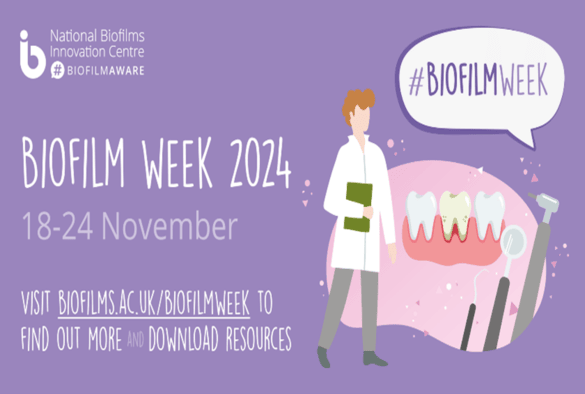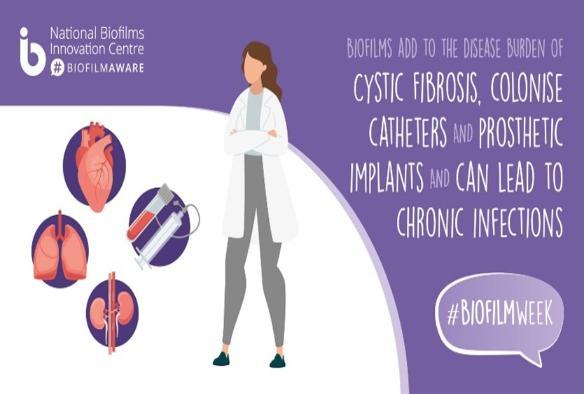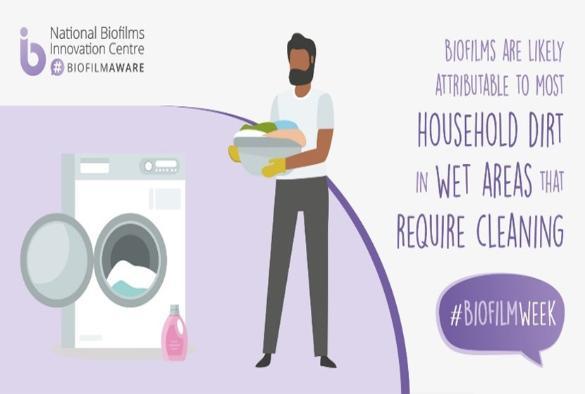AMR and Biofilm awareness week

Antimicrobial resistance (AMR) is one of the major challenges of the 21st-century. AMR is a result of changes in microorganisms like bacteria and fungi, making them resistant to treatment with compounds like antibiotics and antifungals. AMR affect all aspects of life from medicine, where it results in failure to treat infections, to agriculture, industry and environmental issues. Organisations like the World Health Organisation (WHO), the Center for Disease Control (CDC) and the UK Health authorities have raised the alarm of a potential post-antibiotic future reality and highlighted the urgent need for novel compounds and alternative solutions to traditional antimicrobial therapy.
Biofilms are a main contributor to AMR. They are dense communities of microorganisms, encased in a self-produced matrix structure, which provides structural stability and protection. They are also a perfect environment for the exchange of genetic material between bacteria, spreading antimicrobial resistance genes within the community, leading to an increase in AMR. Tackling biofilms is crucial in the fight against AMR. Surface science research provides us with new insights to enable us to engineer advanced surfaces that inhibit, attack or stop microorganisms from becoming virulent biofilms, and therefore can prevent infection. At the University of Liverpool, our work sits at the vanguard of this emerging field, seeking to translate frontier research into antimicrobial technology platforms.
World AMR Awareness Week (WAAW) and Biofilm Week coincide each year with the hope that this will highlight the relationship between Antimicrobial Resistance (AMR) and biofilms.
Taking place from 18-24 November 2024!
The Open Innovation Hub for Antimicrobial Surfaces is a dynamic multi-disciplinary initiative to develop new processes and technologies, tackling the economic burden of microbial activity on materials, surfaces and interfaces in UK industry, and addressing the urgent problem of increasing AMR.
The Hub brings together the expertise, ideas and resources, allowing academic, clinical and industrial partners to share knowledge and innovation in the science of antimicrobial surfaces.
In 2017, the Open Innovation Hub for Antimicrobial Surfaces became a co-founding partner of the £26m collaborative National Biofilms Innovation Centre (NBIC). Funded by the UK’s Biotechnology and Biological Sciences Research Council, Innovate UK, and the STFC Hartree Centre, NBIC is a collaboration between the universities of Liverpool, Southampton, Nottingham and Edinburgh, with 59 associate research institutions and a growing base of more than 250 companies. NBIC was established to deliver the breakthroughs needed to prevent, detect, manage and engineer biofilms, placing the UK at the very forefront of science and innovation in this critical field.
Biofilm Week aims to promote the economic and physical impact that biofilms have on our world, as well as highlight research taking place to prevent, detect, manage and engineer biofilms. Biofilm Week is part of NBIC’s wider #BiofilmAware campaign, which is all about helping people to understand what biofilms are and why biofilms are so important, whilst at the same time raising awareness of biofilm-related research.


Research Highlights
Abigal Johnson is working in NBIC’s Open Innovation Hub for Antimicrobial Surfaces at the University of Liverpool to guide the development of highly efficient antimicrobial coatings on glass. Antimicrobial glass coatings provide an important technology to prevent the formation of harmful biofilms on surfaces, which can contribute to persistence and transmission of infections. This project is in collaboration with NSG Pilkington’s and focusses on a novel antimicrobial glass coating suitable for use in a variety of settings, such as hospitals.
Andrei Barbulescu is exploring the potential use of antimicrobial nanoparticles as coatings to combat microbial growth and prevent the spread of infectious diseases. These nanoparticles offer increased broad-spectrum antimicrobial activity thanks to their enhanced surface area-to-volume ratio. Preventing growth on surfaces is crucial as it inhibits biofilm attachment, thereby negating further biofilm development into mature biofilms that are more difficult to treat. Their application in industrial settings will ensure sustained product performance by preventing microbial growth, ultimately contributing to reduced operational costs.
Amy Foo Guest is focused on designing a model system in the context of oral health to understand the interaction between antimicrobial surfaces and bacteria. This project is in collaboration with Unilever and aims to contribute to the development of novel technologies for the prevention of biofilm formation in dental surfaces.
Kyle Phillips is using atomic force microscopy (AFM) to investigate the nanoscale properties of surfaces, with a particular emphasis on combating biofilm formation. AFM imaging provides detailed insights into surface structures, enabling the design of antifouling materials that inhibit bacterial attachment. We have used inherently antifouling 2D protein arrays as a starting point. Additionally, AFM allows for precise measurement of bacterial adhesion forces, offering a deeper understanding of how surface properties influence the initial attachment of a bacterium to a surface.
Publication Highlights!
Coenye, T., Ahonen, M., Anderson, S., Cámara, M., Chundi, P., Fields, Raval, R., Webb, J. S. (2024). Global challenges and microbial biofilms: Identification of priority questions in biofilm research, innovation and policy. Biofilm, 8, 100210. doi:10.1016/j.bioflm.2024.100210
Morris, G., Goodman, S., Sorzabal Bellido, I., Milanese, C., Girella, A., Pallavicini, P., Raval, R. (2023). Temperature and pH Stimuli-Responsive System Delivers Location-Specific Antimicrobial Activity with Natural Products. ACS applied biomaterials, 7(1), 131-143. doi:10.1021/acsabm.3c00588
Camara, M., Green, W., MacPhee, C. E., Rakowska, P. D., Raval, R., Richardson, M. C., . . . Webb, J. S. (2022). Economic significance of biofilms: a multidisciplinary and cross-sectoral challenge. NPJ BIOFILMS AND MICROBIOMES, 8(1). doi:10.1038/s41522-022-00306-y
Sorzabal-Bellido, I., Barbieri, L., Beckett, A. J., Prior, I. A., Susarrey-Arce, A., Tiggelaar, R. M., . . . Raval, R., Fernandez, Y. A. D. (2022). Effect of Local Topography on Cell Division of Staphylococcus spp. NANOMATERIALS, 12(4). doi:10.3390/nano12040683
Smith, Jessica A, Mulhall, Ross, Goodman, Sean, Fleming, George, Allison, Heather, Raval, Rasmita and Hasell, Tom (2020) Investigating the Antibacterial Properties of Inverse Vulcanized Sulfur Polymers. ACS Omega, 5 (10). pp. 5229-5234.